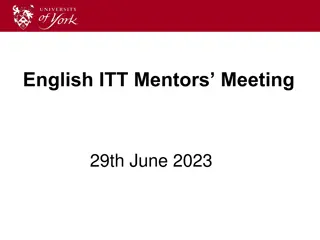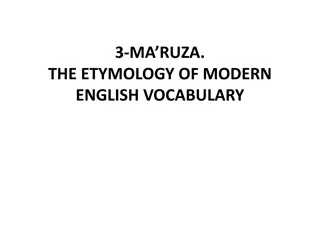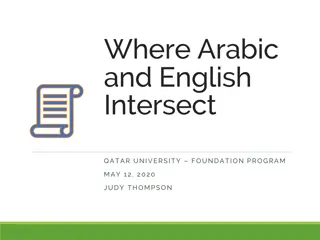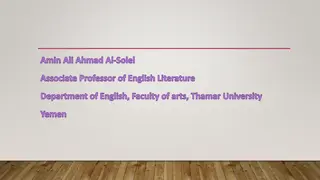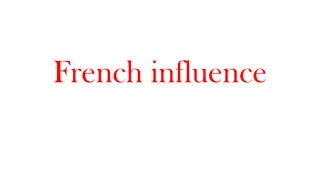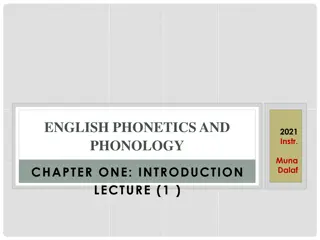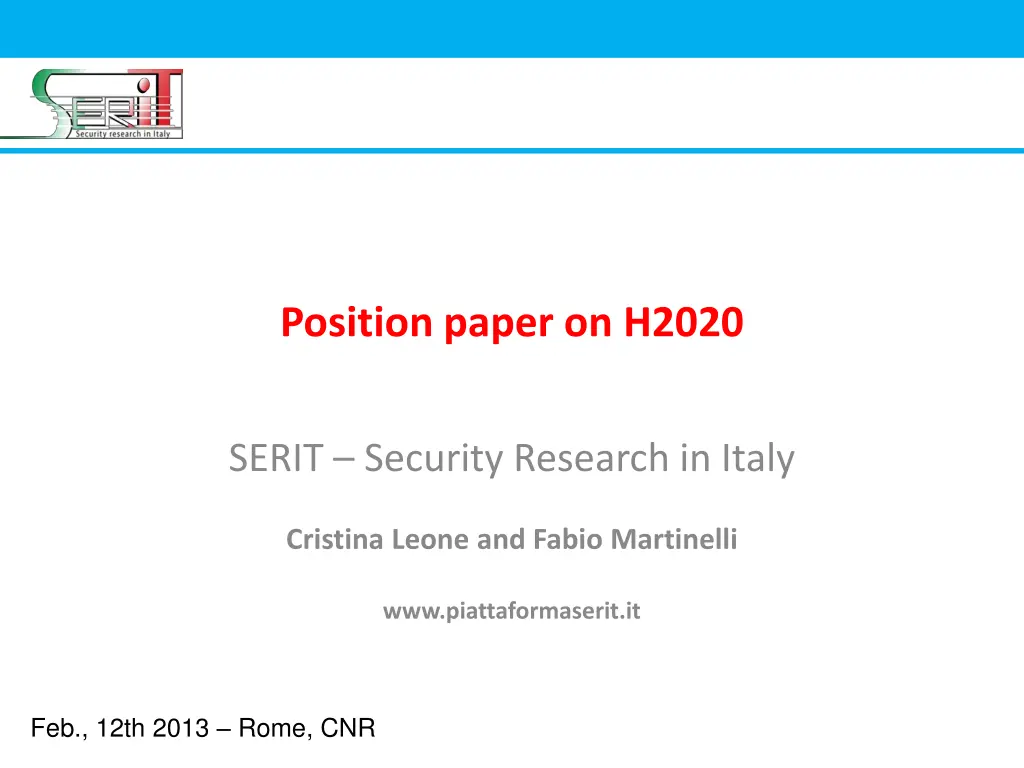
SERIT Security Research in Italy Overview
SERIT is an Italian Technological Platform focusing on Security Research, aiming to strengthen National and International Cooperation, promote Human Resources Development, and contribute to national technology innovation. With over 300 members representing various organizations, SERIT operates in 8 Sectors and 7 Technological Areas aligned with European strategic vision.
Download Presentation

Please find below an Image/Link to download the presentation.
The content on the website is provided AS IS for your information and personal use only. It may not be sold, licensed, or shared on other websites without obtaining consent from the author. If you encounter any issues during the download, it is possible that the publisher has removed the file from their server.
You are allowed to download the files provided on this website for personal or commercial use, subject to the condition that they are used lawfully. All files are the property of their respective owners.
The content on the website is provided AS IS for your information and personal use only. It may not be sold, licensed, or shared on other websites without obtaining consent from the author.
E N D
Presentation Transcript
Position paper on H2020 SERIT Security Research in Italy Cristina Leone and Fabio Martinelli www.piattaformaserit.it Feb., 12th 2013 Rome, CNR
AGENDA and GOAL Agenda 10.30-10.40 Welcome 10.40-11.00 Presentation of the SERIT Platform 11.00-12.30 Presentation of the SERIT Position Paper for Horizon 2020 12.30-13.15 Discussion 13.15-13.30 Conclusion and wrap-up Goal Present the current SERIT position paper for H2020 to institutional stakeholders
SERIT SEcurity Research in ITaly SERIT is the Italian Technological Platform, jointly launched by CNR and Finmeccanica, which brings together Italian industries (both large industries and SMEs), academia, research centers and end-users, in order to promote and develop a ResearchAgenda for future technological developments, answering to the identified NationalSecurityneeds.
High Level Objectives Reinforce National and International Cooperation and competitiveness: SERIT aggregates a number of experts and competencies under different domains, stimulating a fruitful network among stakeholders, users , technologies experts and national institutions. SERIT promotes a dialogue with end-users and national stakeholders to bridge the industrial and academic research with the real needs and requirements expressed by users. SERIT acts as a catalyst to access to both national and European funds for research. Promote the development of Human resources in Security research: SERIT aims to promote and to develop the human capital in security, by promoting and supporting PhD. in collaboration with industries and academic members of the platform, in order to maintain the national excellences and the know-how in security research. Contribute to the national technology development and innovation: SERIT has defined a national technology roadmap.
SERIT is composed by more than 300 members representing more than 250 different organizations Others; 15 Confederations ; Academia Consortia; 5 6 End-Users, 42 Research Institutions; 71 Universities`; 40 Large SMEs; 57 Industries; 36
SERIT a Matrix Organization Technological Areas and Sectors SERIT had been organized according a Matrix structure composed by 8 Sectors (representing the different area where Security needs to be investigated in Italy) and 7 Technological Areas (identifying the technological priorities). The structure has been aligned with a wider European strategic vision, always keeping into account the national requirements and priorities identified, by SERIT Members.
Matrix Situation Awareness Cultural heritage and Building protection Communications Energy Supply System Security Transportation Security Smart Cities Security Borders Security Agrifood Security Detection & Identification Health Security Cybersecurity Information Technologies Technologies for Crisis Management & People, Assets and Infrastructures Protection CBRNE Legal & Etical Issues
STATUS The platform is in continous growth From 50 to near 300 institutes/departments/organizations since 2011 Main results: Formal recognition from MIUR as an Italian Technological Platform Communication strategy based on web site, newsletters and mailing lists (more than 1200 addresses) Two research roadmaps (2011/2012) published and presented to the Italian community; Fostering a culture for competitive funding acquisition (several research projects proposals have been created -both at national and international level); Institution of a SERIT label for PhD fellowships (two awarded from University of Naples); The Security research day organized at CNR on June 27 with the cooperation of APRE; The creation of the SERIT Award (won by IREA in Naples for 2012);
Methodology : how to develop Technologies enabling the needed capabilities for each Domain In 2011, SERIT was mainly focused on the identification of those required capabilities at National level, through the jointly activities among Sectors (application domains) e Technological Areas representatives (results presented in vol.1); Domain 1 Domain 8 Domain 2 Technolo gy Area 1 Technology Area 1 Research themes (capabilities) Technology Area 2 Technolo gy Area 2 Technology Area 7 Then, a further identification of priorities for research, taking into account European Programs (FP7, H2020, etc) guidelines; Latest results achieved on 2012,have been published on SERIT vol.2, showing the Research Priorities definition process, gap analysis, costs associated for further developments, evaluation of TRL , and innovation as a result of technological roadmap
SERIT Roadmap the concept vs H2020 H2020 Missions SERIT SG Techs TRL/Fundings Fighting crime and terrorism Transpor tation Security 1 2 Capabilities Border security Energy Supply Security 3 4 Cyber security Agrifood Security 5 Responding to and managing crises and disasters 6 Health and Security Privacy and freedom in the internet and enhancing the societal dimension of security n 2012 2013 2020
SERITRoadmap the concept vs H2020 An example: Fighting crime and terrorism Transportatio n Security Energy Supply security 3.3 Individuazione di eventi anomali Sorveglianza & Situation TECHNOLOGYAREAS Awareness Comunicazioni Detection & Identification Systems Information Processing and Management CBRNE
Associated Technologies Capabilities TRL 1-3 TRL 4-6 TRL 7-9 Technologies Architetture Software 4.1 4.2 4.3 4.4 4.5 4.6 4.7 4.8 1 2 3 4 5 6 7 8 9 Biometrics Command & Information Systems Integration Data collection, classification & analysis Data Fusion Ground Platforms Interoperability LADARs, LIDARs equipments Mobile sensors networks info collection Modelling and Simulation Sensor related imaging and mapping techniques Tecnologia per l elaborazione numerica di immagini e pattern - Re-identificazione Tecnologie a raggi X Tecnologie Gamma Tecnologie Multispettrali Wide-scale long-range multi-sensor surveillance
What is Horizon 2020 Horizon 2020 is the EU Framework Programme for Research and Innovation It is the financial instrument implementing the Innovation Union concept, the Europe 2020 flagship initiative aimed at securing Europe's global competitiveness Running from 2014 to 2020with an 80 billion budget*, the EU s new programme for research and innovation is part of the drive to createnewgrowth and jobs in Europe.
A time line for Horizon 2020 Past events May 2012: Partial general approach (Council) on H2020 Oct 2012: Partial general approach (Council) on RfP Nov 2012: ITRE vote (EP) on H2020, spec. Programme, Euratom, RfP Dec 2012: Partial general approach (Council) on spec. progr H2020 17/01/2013 Rules for Participation 25/01/2013 Horizon 2020 Preparation of the Trilogue 31/01/2013 Trilogue - Preparation of Competitiveness Council Items 18 February 2013 Competitiveness Council Mar2013: Parliament and Council view on EU (Tri-logues) budget 2014-2020 (including overall budget for Horizon 2020) 2013: Parliament votes on H2020 and RfP Mid 2013: Adoption of legislative acts by Parliament and Council on Horizon 2020 1/1/2014: Horizon 2020 starts, launch of first calls
The H2020 New Structure Horizon 2020 Priorities
Societal challenges Proposed funding (M , 2014-2020) Table 2: EP POSITION ITRE 28 NOV 2012 (Text of CA on 26th Nov) Table 1: EC PROPOSAL DELTA 350,96 New -1 (a) new. Science for and with Society 1. Health, demographic change and wellbeing; 9077 of which 292 for EIT 7896,6 -13% 1. Health and wellbeing 2. Food quality, safety and security, sustainable agriculture and forestry, marine and maritime research and the bio-based industries 2. Food security, sustainable agriculture, marine and maritime research and the bio- economy; 4694 of which 150 for EIT 4299,26 -8,40% 6537 of which 210 for EIT 7370,16 12,74% 3. Secure, clean and efficient energy 3. Secure, clean and efficient energy 7690 of which 247 for EIT 4. Smart, green and integrated transportand mobility 6054,06 -21,27% 4. Smart, green and integrated transport 5. Climate action, environment, resource efficiency and sustainable use of raw materials; 3573 of which 115 for EIT 5. Climate action, resource efficiency and raw materials 3509,6 -1,77% 6. Understanding Europe in a changing world - inclusive, innovative and reflective society 6 (a) new Protecting freedom and security in Europe 4317 of which 138 for EIT 1491,58 6. Inclusive, innovative and secure societies -22,76% 1842,54
Specific thematics addressed by SERIT In particular we refer to the last available proposals from Commission, Council and Parliament and the specific themes we addressed are: III Societal challenges, 6a. Secure societies protecting freedom and security of Europe and its citizens (a) fight crime and terrorism; (b) protect and improve resilience of critical infrastructures; (c) strengthen security through border management and maritime security; (d) provide cyber security; (e) increase Europe's resilience to crises and disasters; (f) enhance the societal dimension of security and ensure privacy and freedom in the Internet; (g) support the Union's internal and external security policies; (h) strengthen security and the transformation of conflicts within third countries through conflict prevention, peace-building, dialogue, mediation and reconciliation and civilian security sector reform; (i) enhance standardization and interoperability; III Societal challenges, 3. Secure, clean and efficient energy 3.1.3. Foster European Smart cities and Communities III Societal challenges, 5. Climate Action, Resource Efficiency and Raw Materials 5.6. Cultural heritage
Questi temi sono quelli indicati nella sottotematica prima presente nel 6 pilar Societal challenges Protecting freedom and security in Europe Commissione Consiglio Parlamento 6.3.1. Fighting crime and terrorism. 7.1. Fight crime, illegal trafficking and terrorism, including understanding and tackling terrorist ideas and beliefs (a) fight crime and terrorism; 7.2. Protect and improve the resilience of critical infrastructures, supply chains and transport modes (b) protect and improve resilience of critical infrastructures; 6.3.2. Strengthening security through border management 7.3. Strengthen security through border management c) strengthen security through border management and maritime security; 6.3.3. Providing cyber security 7.4. Improve cyber security (d) provide cyber security; 6.3.4. Increasing Europe's resilience to crises and disasters 7.5. Increase Europe's resilience to crises and disasters (e) increase Europe's resilience to crises and disasters; 6.3.5. Ensuring privacy and freedom in the internet and enhancing the societal dimension of security 7.6. Ensure privacy and freedom, including in the Internet and enhancing the societal legal and ethical understanding of all areas of security, risk and management (f) enhance the societal dimension of security and ensure privacy and freedom in the Internet; (g) support the Union's internal and external security policies; (h) strengthen security and the transformation of conflicts within third countries through conflict prevention, peacebuilding, dialogue, mediation and reconciliation and civilian security sector reform; 7.7. Enhance standardisation and interoperability of systems, including for emergency purposes (i) enhance standatisation and interoperability;
SPEAKERS Secure societies protecting freedom and security of Europe and its citizens (a) fight crime and terrorism M.Trussardi (Selex-ES) (b) protect and improve resilience of critical infrastructures S. Bologna (AIIC) (c) strengthen security through border management and maritime security S.Pasquariello (Selex ES) (d) provide cyber security L.Romano (CINI) (e) increase Europe's resilience to crises and disasters P.Fichera (ENEA) (f) enhance the societal dimension of security and ensure privacy and freedom in the Internet M.Savastano (CNR) (g) support the Union's internal and external security policies; M.A.Corbucci (Finmeccanica) per F.Di Camillo (IAI) (i) enhance standardization and interoperability M.Luglio (Univrsit Tor Vergata) Secure, clean and efficient energy 3.1.3. Foster European Smart cities and Communities V.Cuomo (CNR) Climate Action, Resource Efficiency and Raw Materials 5.6. Cultural heritage L. Moltedo (CNR)


